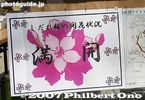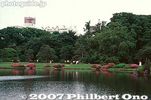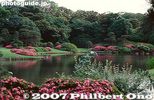|
|

A long line forms at Rikugien's Someimon Gate entrance. When the weeping cherry tree is in bloom in late March, many people come. 染井門
|
|

Even the main Seimon entrance is crowded with people. This is a weekday. Admission 300 yen. 正門
|
|

Seimon Gate entrance to Rikugien Garden.
|
|

Sign says the weeping cherry tree is in full bloom (mankai). 「しだれ桜 満開」
|
|

Rikugien Garden's famous weeping cherry tree. In Japanese, it is called "shidare-sakura" meaning drooping cherry.
|
|

A large crowd admire the beautiful weeping cherry tree.
|
|

When this weeping cherry tree is in bloom, the garden is open at night and this tree is lit up.
|
|

Very difficult to take a picture of the tree without any people in it.
|
|

Rikugien is one of the nicest Japanese gardens in central Tokyo, and one of two of Edo's famous gardens (other is Koishikawa Korakuen). The garden was built in 1702 by Lord Yanagisawa Yoshiyasu from Kawagoe, who was a favorite ally of Shogun Tokugawa Tsunayoshi, the 5th Tokugawa Shogun. It is a Kaiyu-type (stroll around a central pond) Daimyo garden with hills and ponds. Near Komagome Station on the Yamanote Line.
|
|

Weeping cherry flowers.
|
|

Closeup of flowers.
|
|

Side view
|
|
|
|
|
|

Under the shower of weeping flowers.
|
|
|
|

Tree trunk
|
|
|

The many low-hanging branches are supported by wooden posts.
|
|

How the tree looks after it finishes blooming.
|
|

When the weeping cherry tree is in bloom, Rikugien Garden also illuminates the tree at night in late March to early April.
|
|

Very beautiful, but very crowded.
|
|
|
|
|
|

Picture-taking frenzy around Rikugien's weeping cherry tree.
|
|
|
|
|
|

They also light up the pine trees in spring, similar to autumn.
|
|

Rikugien also has a second weeping cherry tree. Very tall and in full bloom at the same time as the more famous tree.
|
|

This tall weeping cherry tree looks totally different from different angles.
|
|

Like a cherry tree monster.
|
|

Part of the illumination was pink.
|
|
|
|
|
|

Rikugien Garden's second weeping cherry tree at night.
|
|
|
|
|
|
|

A long line to get in Rikugien at night in spring. It proceeds quickly though.
|
|

The name, Rikugi-en, came from "six elements of Waka poems" that had been derived from "six styles of poems" written in the old Chinese poetry book "Mao-shi".
|
|

This is a big pond with small islands and surrounded by trees. There are replicas of famous Japanese scenery such as Wakanoura in Kishu (Wakayama Prefecture).
|
|

During the Meiji Period, Rikugien became a villa owned by the Iwasaki family who founded the Mitsubishi corporate empire and was donated to Tokyo and opened to the public in 1938.
|
|

Rikugien was desinated as one of Japan's Special Scenic Spots in 1953. 国の特別名称
|
|

Azalea bushes and pond
|
|

Pines
|
|
|
|

Drooping pine tree, Rikugien Garden, Tokyo
|
|

Cherry blossoms and pine tree
|
|

Somei Yoshino cherry blossom tree
|
|

Pond
|
|

All kinds of matsu pine trees
|
|

Matsu
|
|

Pine tree
|
|

Azaleas in bloom
|
|

Azaleas in bloom
|
|
|

The garden is also colorful in autumn.
|
|
|
|
|
|
|
|

Leaves straight up
|
|
|
|

Maples
|
|
|
|
|

Momiji
|
|
|
|
|
|
|
|
|
|
|
|
|
|
|

Looks like the trees are on fire. Rikugien Garden, Tokyo
|
|
|
|
|
|

Bridge at Rikugien Garden, Tokyo
|
|
|

Rikugien Garden, Tokyo
|
|
|
|
|
|
|
|
|
|

Rikugien is also open at night during the autumn foliage season in Nov. Expect a long line.
|
|

Entrance
|
|
|
|

Tall bamboo illuminated. Very subtle colors against the black sky.
|
|

Chrysanthemum display
|
|

Pine trees and autumn leaves lit up at Rikugien Garden.
|
|
|
|
|
|
|
|
|
|
|
|
|
|
|
|
|
|
|

Japanese pine tree in fantastic shapes.
|
|
|

Weeping cherry tree in fall.
|
|
|
|
|
|
|
|
|
|
|
|
|
|
|
|
|
|
|
|
|
|
|
|
|
|
|
|
|